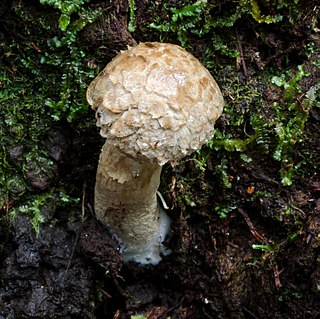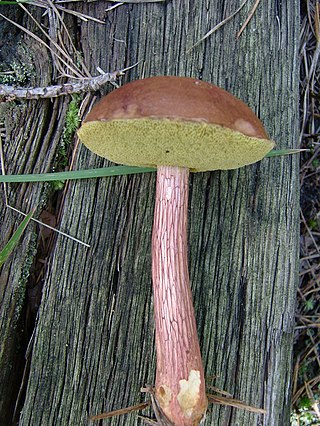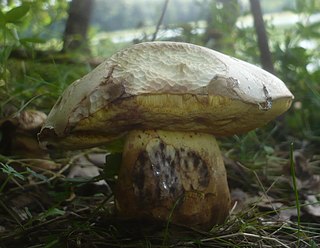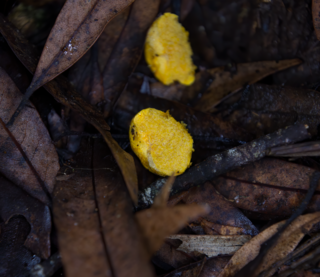
The Boletaceae are a family of mushroom-forming fungi, primarily characterised by small pores on the spore-bearing hymenial surface, instead of gills as are found in most agarics. Nearly as widely distributed as the agarics, the family is renowned for hosting some prime edible species highly sought after by mushroom hunters worldwide, such as the cep or king bolete . A number of rare or threatened species are also present in the family, that have become the focus of increasing conservation concerns. As a whole, the typical members of the family are commonly known as boletes.
Edred John Henry Corner FRS was an English mycologist and botanist who occupied the posts of assistant director at the Singapore Botanic Gardens (1929–1946) and Professor of Tropical Botany at the University of Cambridge (1965–1973). Corner was a Fellow of Sidney Sussex College from 1959.

Tylopilus is a genus of over 100 species of mycorrhizal bolete fungi separated from Boletus. Its best known member is the bitter bolete, the only species found in Europe. More species are found in North America, such as the edible species T. alboater. Australia is another continent where many species are found. All members of the genus form mycorrhizal relationships with trees. Members of the genus are distinguished by their pinkish pore surfaces.

Afroboletus is a genus of fungi in the family Boletaceae. The genus, circumscribed in 1981, contains seven species found in tropical Africa.

Boletellus is a genus of fungi in the family Boletaceae. The genus has a widespread distribution, especially in subtropical regions, and contains about 50 species. The genus was first described by American mycologist William Alphonso Murrill in 1909. The genus name means "small Boletus".

Fistulinella is a genus of bolete fungi in the family Boletaceae. The genus has a pantropical distribution, and contains 15 species. Fistulinella was circumscribed by German mycologist Paul Christoph Hennings in 1901.

Boletellus obscurecoccineus, known as the rhubarb bolete, is a species of fungus in the family Boletaceae, found in Australia, New Guinea, Java, Borneo, Japan, Korea, and Taiwan. It is a distinctive and colourful bolete of the forest floor.

Ramariopsis is a genus of coral fungi in the family Clavariaceae. The genus has a collectively widespread distribution and contains about 40 species. The name means 'having the appearance of Ramaria'.

Aureoboletus mirabilis, commonly known as the admirable bolete, the bragger's bolete, and the velvet top, is an edible species of fungus in the Boletaceae mushroom family. The fruit body has several characteristics with which it may be identified: a dark reddish-brown cap; yellow to greenish-yellow pores on the undersurface of the cap; and a reddish-brown stem with long narrow reticulations. Aureoboletus mirabilis is found in coniferous forests along the Pacific Coast of North America, and in Asia. Unusual for boletes, A. mirabilis sometimes appears to fruit on the wood or woody debris of Hemlock trees, suggesting a saprobic lifestyle. Despite the occasional appearances to the contrary, Aureoboletus mirabilis is mycorrhizal, and forms a close association with the tree's roots.
Strobilomyces foveatus is a little-known species of fungus in the family Boletaceae. It was first reported by mycologist E.J.H. Corner in 1972, from specimens he collected in Malaysia in 1959, and has since been found in Australia. Fruit bodies are characterized by the small dark brown to black conical scales covering the cap, and the net-like pattern of ridges on the upper stem. The roughly spherical spores measure about eight micrometres, and are densely covered with slender conical spines. The edibility of this species is unknown.

Boletellus ananas, commonly known as the pineapple bolete, is a mushroom in the family Boletaceae, and the type species of the genus Boletellus. It is distributed in southeastern North America, northeastern South America, Asia, and New Zealand, where it grows scattered or in groups on the ground, often at the base of oak and pine trees. The fruit body is characterized by the reddish-pink scales on the cap that are often found hanging from the edge. The pore surface on the underside of the cap is made of irregular or angular pores up to 2 mm wide that bruise a blue color. It is yellow when young but ages to a deep olive-brown color. Microscopically, B. ananas is distinguished by large spores with cross striae on the ridges and spirally encrusted hyphae in the marginal appendiculae and flesh of the stem. Previously known as Boletus ananas and Boletus coccinea, the species was given its current name by William Alphonso Murrill in 1909. Two varieties of Boletellus ananas have been described. Like many other boletes, this species is considered edible, but it is not recommended for consumption.
Aureoboletus longicollis is a species of fungus in the family Boletaceae. First described under the name Boletus longicollis in 1879, it was transferred to the genus Boletellus in 1981 before being transferred to Aureoboletus in 2015.

Boletellus emodensis, commonly known as the shaggy cap, is a species of fungus in the family Boletaceae. It was described by English mycologist Miles Joseph Berkeley in 1851 as Boletus emodensis, and transferred to Boletellus by Rolf Singer in 1942. Characterised by a distinctive reddish shaggy cap, it grows in eucalypt woodlands. It produces a brown spore print, and has fusiform (spindle-shaped) spores that are 16–20 by 7–9 μm with longitudinal grooves. It is similar in appearance to Boletellus ananiceps, but the latter species is scaly rather than shaggy, has a pinkish tint, and lacks grooves in the spores.

Boletellus ananaeceps is a species of fungus in the family Boletaceae. First described by Miles Joseph Berkeley under the name Boletus ananaeceps in 1873, it was transferred to Boletellus in 1955 by Rolf Singer. It is found in Australia.

Aureoboletus projectellus is a species of bolete fungus in the family Boletaceae. Found in North America, and recently in Europe, it grows in a mycorrhizal association with pine trees.
Tylopilus funerarius is a bolete fungus in the family Boletaceae. Found in Singapore, it was described as new to science in 1909 by English mycologist George Edward Massee. He described it as a "sombre, uninviting species, characterised by brownish-black velvety pileus and brown tube and pores", and considered it similar in appearance to Boletus chrysenteron. The species was transferred to the genus Tylopilus in 1981.

Caloboletus kluzakii is a bolete fungus native to Europe. Until 2014, it was known as Boletus kluzakii. Recent changes in the phylogenetic framework of the family Boletaceae prompted the transfer of this species, along with several other related boletes, including Caloboletus calopus, to the genus Caloboletus. It was described scientifically in 2006 by Josef Šutara and Pavel Špinar, from specimens collected in the Czech Republic. The fungus had earlier been published with the name Boletus fallax by Czech mycologist Zdeněk Kluzák in 1988, but this was invalid, as that name had been used previously by E.J.H. Corner for a Malaysian bolete. The epithet honours Kluzák's contributions in describing the species.

Stephanospora is a genus of truffle-like gasteroid fungi in the order Agaricales. In 2014, nine new Australasian species were described from collections previously thought to represent S. flava.
Gyrodon ripicola is a bolete fungus in the family Paxillaceae. Found in Singapore, the species was first described in 1971 by E.J.H. Corner as a species of Paxillus. Pegler and Young transferred it to the genus Gyrodon in 1981.













